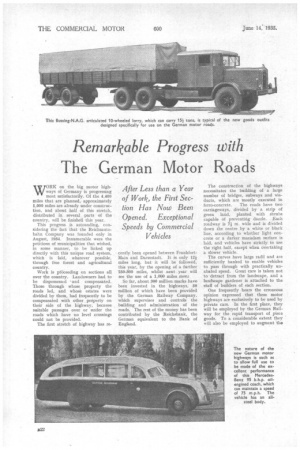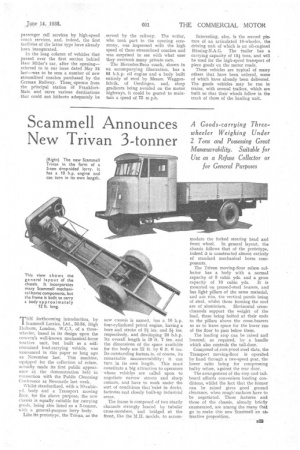Remarkable Progress with The German Motor Roads
Page 32

Page 33

If you've noticed an error in this article please click here to report it so we can fix it.
After Less than a Year of Work, the First Section Has Now Been Opened. Exceptional Speeds by Commercial Vehicles
WORK on the big motor highways of Germany is progressing most satisfactorily. Of the 4,400 miles that are planned, approximately 1,000 miles are already under construction, and about half of this stretch, distributed in several parts of the country, will be finished this year.
This progress is astounding, considering the fact that the Reichsautobahn Company was founded only in August, 1934. Innumerable were the petitions of municipalities that wished, in some manner, to be linked up directly with this unique road system, which is laid, wherever possible, through free forest and agricultural country.
Work is pfoceecling on sections all over the country. Landowners had to be dispossessed 'and compensated. Those through whose property the roads led, and whose estates were divided by them, had frequently to be compensated with other property on their side of the highway, because suitable passages over or under the roads which have no level crossings could not be provided.
The first stretch of highway has re
cently been opened between FrankfortMain and Darmstadt. It is only 124 miles long, but it will be followed, this year, by the opening of a further 250-300 miles, whilst next year will see the use of a 1,000 miles mon.:
So far, about 300 million marks havebeen invested in the highways, 50 million of which have been provided by the German Railway Company, which supervises and controls the building and administration of the roads. The rest of the money has been contributed by the Reichsbank, the German equivalent to the Bank of England. The construction of the highways necessitates the building of a large number of bridges, subways and viaducts, which are mostly executed in ferro-concrete. The roads have two carriageways, divided by a strip of green land, planted with shrubs capable of preventing dazzle. ach roadway is 7f m. wide and is divided down the centre by a white or black line, according to whether light concrete or a darker macadam surface is laid, and vehicles have strictly to use the right half, except when overtaking a slower vehicle.
The curves have large radii and are sufficiently banked to enable vehicles to pass through with practically unabated speed. Great care is taken not to detract from the landscape, and a landscape gardener is attached to the staff of builders of each section.
One frequently hears the erroneous opinion expressed that these motor highways are exclusively to be used by private cars. In the first place, they will be employed by the German Railway for the rapid transport of piece goods. To a considerable extent they will also be employed to augment the passenger rail services by high-speed coach services, and, indeed, the first facilities of the latter type have already been inaugurated.
In the long column of vehicles that passed over the first section behind Herr Hitler's car, after the opening— referred to in our issue dated May 24 last—was to be seen a number of new streamlined coaches purchased by the German Railway. These...operate from the principal station of FrankfortMain and serve various destinations that could not hitherto adequately be , served by the railway. The writer, who took part in the opening ceremony, was impressed with the high speed of these streamlined coaches and was surprised to see with what ease they overtook many private cars.
• The Mercedes-Benz coach, shown in an accompanying illustration, has a 95 b.h.p. oil engine and a body built entirely of steel by Messrs. Waggonfabrik, of lIerdingen, and, steep gradients being avoided on the motor, highways, it could be geared to maintain a speed of 75 m.p.h. Interesting, also, is the second picture of an articulated 10-wheeler, the driving unit of which is an oil-engined Btissing-N.A.G. The trailer has a carrying capacity of 15f tons, and will be used for the high-speed transport of piece goods on the motor roads.
These vehicles are typical of many others that have been ordered, some of which have already been delivered. The goods vehicles may be run in trains, with several trailers, which are built so that their wheels follow in the track of those of the hauling unit.




















































































